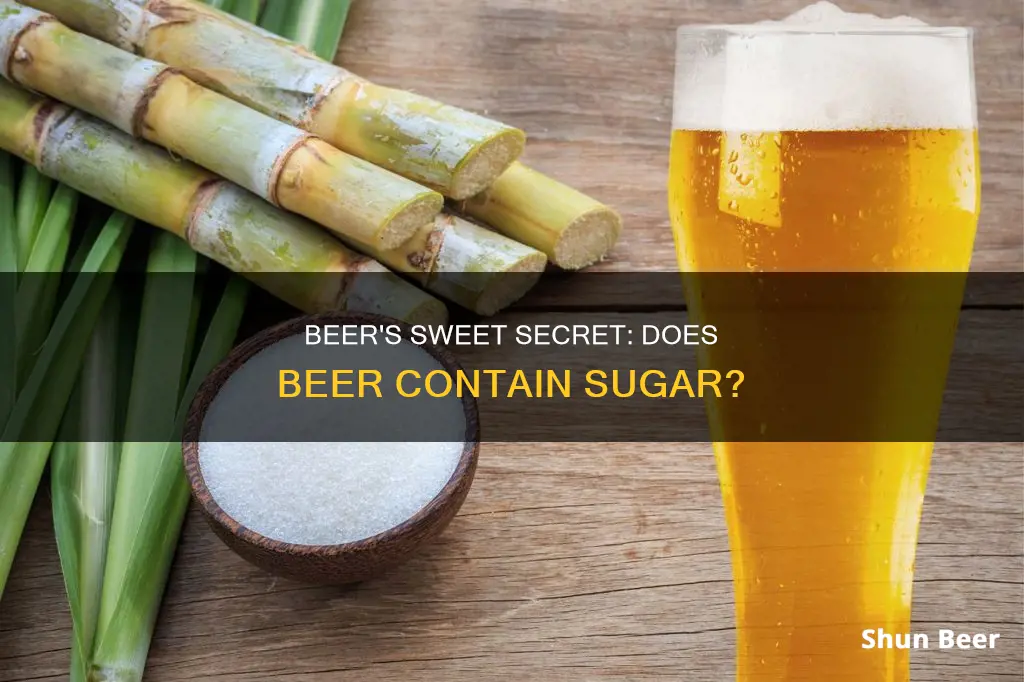
Beer is a beloved beverage for many, but what about its sugar content? The answer is a bit complex. While beer does contain sugar, the amount varies depending on the type of beer and the brewing process. Most beers have little to no added sugar, but they do contain carbohydrates that can affect blood sugar levels. The sugar in beer comes from the fermentation process, where yeast converts fermentable sugars into alcohol and carbon dioxide, leaving behind varying levels of residual sugars. Understanding beer gravity, or the density of the wort, is crucial as it influences both the sweetness and alcohol content, with high-gravity beers typically having more residual sugars and stronger flavours. So, while beer may not have a significant amount of sugar, it's important to consider its impact on blood sugar levels, especially for those monitoring their glucose levels or managing health conditions.
| Characteristics | Values |
|---|---|
| Is there sugar in beer? | Yes, but it's a very small amount. |
| How does sugar get into beer? | It's a product of the fermentation process, where yeast converts fermentable sugars into alcohol and carbon dioxide. |
| What type of sugar is in beer? | The most common type of sugar in beer is maltose, a disaccharide made of two glucose molecules. |
| How much sugar is in beer? | The amount of sugar depends on the type of beer. Regular beers have approximately 10.6 grams of carbs and minimal sugar, as most are fermented. Light beers have around 3.2 grams of carbs and virtually no sugar. Non-alcoholic beers have about 12.2 grams of carbs, including more unfermented sugars. |
| How does beer impact blood sugar? | Beer can lower blood sugar levels, which can lead to hypoglycemia. Alcohol impairs sugar metabolism by inhibiting the body's production and breakdown of stored sugar. |
What You'll Learn

Beer's sugar content
Beer does contain sugar, but the amount varies depending on the type of beer and the brewing process. The sugar in beer comes from the fermentation process, where yeast converts fermentable sugars into alcohol and carbon dioxide, leaving behind varying levels of residual sugars. The amount of sugar in beer also depends on the type of yeast and the brewing temperature.
The brewing process for beer typically involves the following steps:
- Malting: Grains (usually barley or wheat) are soaked, germinated, and dried to convert starches into fermentable sugars.
- Mashing: The malted grains are soaked in hot water to release the sugars, creating a sweet liquid called wort.
- Boiling: Hops and other spices are added for flavour and bitterness, and the wort is sterilised.
- Fermentation: Yeast is added to the cooled wort to ferment the sugars, producing alcohol and carbon dioxide.
- Maturation: The beer is stored and left to age, developing flavours and carbonation.
The sugar content in beer can be classified as either fermentable or non-fermentable. Fermentable sugars, such as maltose, are converted into alcohol during the fermentation process. Non-fermentable sugars, such as oligosaccharides, are not digested by the yeast and remain in the beer, adding sweetness and body.
Different styles of beer, such as ales, lagers, and stouts, have distinct sugar profiles due to variations in yeast activity, brewing temperatures, and ingredients used. High gravity beers, which start with a wort rich in sugars, tend to have higher alcohol content and a sweeter taste. In contrast, low gravity beers have lower alcohol content and are less sweet.
Regular beers typically contain moderate amounts of fermentable sugars, which are converted into alcohol. Light beers are crafted to be lower in calories and carbs, with altered fermentation processes to reduce sugar content, resulting in less alcohol and a lighter body. Non-alcoholic beers, on the other hand, can sometimes have higher sugar levels than alcoholic versions since the sugars are not converted into alcohol.
Overall, the sugar content in beer varies depending on the specific type and brewing process, but most beers have relatively low amounts of sugar compared to other alcoholic beverages.
Beer and Yeast Allergies: Is It Safe to Drink?
You may want to see also

How beer is made
Beer is made from four main ingredients: barley, water, hops, and yeast. However, other ingredients such as wheat, maize (corn), rice, and oats are also used. The process of making beer is called brewing, and the basic idea is to extract the sugars from grains (usually barley) so that the yeast can turn it into alcohol and CO2, creating beer.
- Mashing: The first step is to activate the natural enzymes in the yeast by mixing it with very hot water. This process turns the starch in the yeast into sugar, which will later be turned into alcohol. The mashing process creates the base liquid of the beer, known as "wort."
- Lautering: In this step, the wort is separated from the grain by pouring heated water over it to rinse off any remaining sugars. This ensures that the yeast can do its job effectively.
- Boiling: The wort is then boiled at a very high temperature to get rid of remaining enzymes and oxygen, and to stabilise the liquid in preparation for the addition of hops.
- Boiling and Fermentation: Hops are added to the boiled wort, giving the beer its distinct character, bitterness, and flavour. The brewing process is now complete, and fermentation begins. The wort is quickly cooled, and yeast is added, or "pitched." Fermentation is a two-part process where the yeast converts the sugars into alcohol and carbon dioxide.
- Bottling and Conditioning: After fermentation, the final gravity reading is taken to determine the alcoholic content. The beer is then bottled, canned, or kegged, and left to condition for at least two weeks.
It's worth noting that there are different brewing methods, such as extract brewing, partial mash, and all-grain, but they all share similar processes, including heating water with grain, adding hops, boiling the mixture, cooling it, adding yeast, and allowing for carbonation.
Is Drinking Day-Old Beer Safe?
You may want to see also

Fermentation
Beer is made from grains, spices, yeast, and water. While sugar is not added as an ingredient, it is necessary to produce alcohol. During the malting stage, grains are germinated, which helps break down stored starch into fermentable sugar, mainly maltose. The germinated grains are then roasted, milled, and soaked in hot water to create a sugar-containing liquid called wort.
During the fermentation process, the yeast absorbs oxygen and multiplies. When the oxygen runs out, the yeast begins to break down the sugar, converting it into alcohol and carbon dioxide. This process is called glycolysis, and it results in the production of pyruvates and ATP (adenosine triphosphate), which supplies energy to the yeast and allows it to multiply. The pyruvates are then converted into carbon dioxide and ethanol by the yeast.
The fermentation process can be divided into three recognised phases: the lag phase, the active phase, and the stationary phase. During the lag phase, the yeast absorbs oxygen and other necessary vitamins and minerals for reproduction and healthy growth. In the active phase, the yeast count increases rapidly, and CO2 is produced, forming a layer of foam called krausen. This is when most of the ethanol and flavour compounds are produced. The stationary phase is when yeast growth slows down, and the beer is conditioned. The krausen falls, and the yeast settles or flocculates.
The fermentation process is carefully monitored to ensure the desired consistency, pH, flavour, and colour of the beer. Temperature is a critical factor, as it determines how well and how quickly fermentation occurs. Gravity readings are also taken at the beginning and end of the process to measure the density of the beer and indicate the amount of alcohol present due to the dissolved sugars.
Children Drinking Beer: Historical Norm or Myth?
You may want to see also

Beer types and sugar content
Beer is generally made from yeast, grains, spices, and water. While sugar is not listed as an ingredient, it is created naturally when grains are processed and fermented by yeast. The sugar content in beer is determined by its gravity, the type of yeast used, and any additional flavours included, such as honey or corn syrup.
Beer Gravity
Beer gravity refers to the density of the liquid extracted from the mashing process during the brewing of beer, known as the wort. When the wort has a lot of sugar, it is called a high-gravity wort. Once yeast is introduced, the sugar content decreases while the alcohol content increases.
Yeast
Yeast ferments sugar, converting it into alcohol and carbon dioxide. Different types of yeast have different alcohol tolerances, which affects the remaining sugar content in the beer. For example, ale yeasts have a higher alcohol tolerance than lager yeasts, resulting in ales with lower sugar content.
Additional Flavours
Beer manufacturers may add ingredients such as honey and corn syrup to their recipes to give their beer a distinctive flavour. These ingredients can increase the sugar content of the beer.
Types of Beer and Their Sugar Content
The sugar content of beer varies depending on the style and brand. Here are the sugar and carb contents of some common types of beer and popular brands, measured per 12 ounces (355 ml) serving:
- Regular beer: 12.8 grams of carbs, 0 grams of sugar
- Light beer: 5.9 grams of carbs, 0.3 grams of sugar
- Low-carb beer: 2.6 grams of carbs, 0 grams of sugar
- Non-alcoholic beer: 28.5 grams of carbs, 28.5 grams of sugar
- Miller High Life: 12.2 grams of carbs, 0 grams of sugar
- Miller Lite: 3.2 grams of carbs, 0 grams of sugar
- Coors Banquet: 11.7 grams of carbs, 0 grams of sugar
- Coors Light: 5 grams of carbs, 1 gram of sugar
- Coors Non-alcoholic: 12.2 grams of carbs, 8 grams of sugar
- Heineken: 11.4 grams of carbs, 0 grams of sugar
- Budweiser: 10.6 grams of carbs, 0 grams of sugar
- Bud Light: 4.6 grams of carbs, 0 grams of sugar
- Busch: 6.9 grams of carbs, no sugar reported
- Busch Light: 3.2 grams of carbs, no sugar reported
It is important to note that the sugar content in beer is generally very low, and labelling regulations in the United States do not require manufacturers to disclose the sugar content of their alcoholic products.
Drinking Beer in Berlin: What's Allowed in Public?
You may want to see also

Health implications of sugar in beer
Beer is generally made from yeast, grains, spices, and water. While sugar is not usually listed as an ingredient, it is created naturally when grains are processed and fermented by yeast. The sugar content of beer depends on several factors, including its gravity, the type of yeast used, and any additional flavours included, such as honey or corn syrup.
The immediate effect of drinking beer is an increase in blood sugar levels due to the beverage's carbohydrate content. However, over a longer period, these levels will decrease as the body processes the alcohol. This can be tricky to manage for those using insulin or other medications that lower blood sugar. For people with diabetes, drinking beer can lead to hypoglycaemia, a potentially dangerous condition where blood sugar falls too low.
Beer can also contribute to weight gain, as sugars are high in calories with minimal nutritional benefit. Excess calories can increase the risk of obesity and type 2 diabetes. Studies suggest that high-sugar diets can lead to obesity, inflammation, high triglyceride levels, and high blood pressure, all of which increase the risk of heart disease. Sugar is also a leading cause of cavities, as the bacteria in the mouth feed on it, producing acids that erode tooth enamel and lead to dental decay.
Consuming too much added sugar, especially from sugary drinks, can lead to an accumulation of fat in the liver, resulting in non-alcoholic fatty liver disease. There is also emerging evidence linking high sugar intake to an increased risk of depression and anxiety. Sugar can induce inflammatory and hormonal changes that may negatively impact mental health.
In summary, while beer has a relatively low sugar content compared to other alcoholic drinks, excessive consumption can lead to negative health effects. These include weight gain, dental issues, and an increased risk of heart disease and type 2 diabetes. Additionally, the alcohol content of beer can interfere with blood sugar regulation, posing challenges for individuals managing diabetes or prediabetes. To avoid negative health consequences, it is important to consume beer in moderation.
Is Corona Beer Safe to Drink?
You may want to see also
Frequently asked questions
Yes, beer contains sugar, but it's not added directly during the brewing process. Instead, the sugars in beer come from the grains used, which are typically barley or wheat.
The brewing process involves several steps that contribute to the final sugar content. Firstly, grains are malted, which involves soaking them in hot water to start germination. This process converts starches in the grains into simple, fermentable sugars, mainly maltose. The malted grains are then soaked again in hot water to create a sweet liquid called wort. During the boiling step, hops and other ingredients are added for flavour and balance. Finally, yeast is introduced to the cooled wort to begin fermentation, converting sugars into alcohol and carbon dioxide.
The main type of sugar in beer is maltose, a disaccharide made from two glucose molecules. Other types of sugar, such as glucose and fructose, may be present in smaller amounts, especially in beers with added fruit.
The amount of sugar in beer varies depending on the type and brand. Regular beers typically contain minimal sugar, as most of it is fermented. Light beers have even less sugar, usually around 0-1 grams per can or bottle. However, non-alcoholic beers tend to have higher sugar content since the sugars are not converted into alcohol.
Beer can affect blood sugar levels in two ways. Firstly, the carbohydrates in beer can cause a temporary spike in blood sugar. However, over a longer period, alcohol in beer can lower blood sugar levels by interfering with the body's ability to produce and regulate glucose. This can lead to hypoglycaemia, especially in individuals with diabetes.







